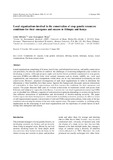Local organizations involved in the conservation of crop genetic resources: conditions for their emergence and success in Ethiopia and Kenya

View/
Date
2006Author
Mburu, John
Wale, Edilegnaw
Type
ArticleLanguage
enMetadata
Show full item recordAbstract
Local organizations comprising of farmers, local formal and informal institutions, and public conservators
can potentially be relevant options to confront the challenges of conserving indigenous crop varieties in
developing countries. Although property rights and market failure problems experienced in crop genetic
resources (CGRs) are different from other natural resources such as forests, wildlife, etc., such local
organizations, and contractual arrangements within them, can be very instrumental in enhancing on-farm
conservation. However, empirical investigations of such local organizations in order to determine the
dimensions of their feasibility have been scarce. Against this background, this paper analyzes interactions
of stakeholders in these local organizations and then explores the conditions for their emergence and
success. The paper discusses field cases of on-farm conservation of traditional cereals and pulses from
Ethiopia and indigenous vegetables from Kenya. It points out that local organizations conserving CGRs
can be classified into different categories of contractual arrangements depending on certain driving factors
that influence interactions of stakeholders and devolvement of decision-making authority. The paper
further argues that these driving factors, which include accessibility to markets, presence of collective action
or self-organizational capacity and provision of relevant CGRs conservation policies, form some of the key
conditions determining the success of the case study organizations. The paper concludes by outlining policy
implications on the structuring of such local organizations and the importance of certain factors in facilitating
their emergence and success.
URI
http://www.google.com/url?sa=t&rct=j&q=&esrc=s&source=web&cd=1&ved=0CCsQFjAA&url=http%3A%2F%2Flink.springer.com%2Fcontent%2Fpdf%2F10.1007%252Fs10722-004-2683-1&ei=KofvUf6tKJOrhQfI-YDgDQ&usg=AFQjCNHRfxYBURMa5I_k_16OcUmuCVfTJQ&bvm=bv.49641647,d.ZG4http://erepository.uonbi.ac.ke:8080/xmlui/handle/123456789/50530
